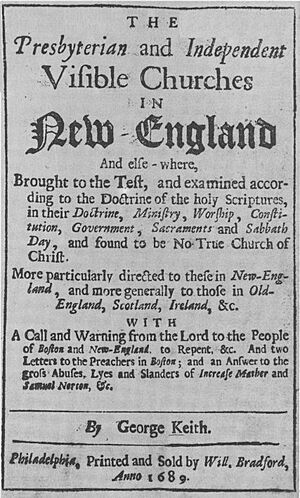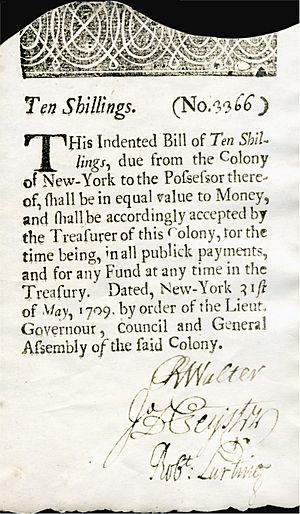William Bradford (printer, born 1663) facts for kids
Quick facts for kids
William Bradford
|
|
|---|---|

William Bradford gravesite
|
|
| Born | May 20, 1663 Barwell, Leicestershire, England
|
| Died | May 23, 1752 (aged 89) |
| Resting place | Trinity Church Cemetery |
| Occupation | Printer |
| Spouse(s) | Elizabeth Sowel |
| Children | Andrew Bradford |
| Relatives | William Bradford (grandson) |
William Bradford (born May 20, 1663 – died May 23, 1752) was an important early American printer and publisher. He is famous for setting up the very first printing presses in the Middle colonies of America. He started the first press in Pennsylvania in 1685. Later, he opened the first press in New York in 1693.
Bradford ran his printing businesses for 62 years! His family continued to be printers and publishers for 140 years. He was also known for fighting for freedom of the press. He began his printing work in London before moving to America in 1685. He also helped create the first paper mill in the Thirteen American Colonies.
During his long career, Bradford printed thousands of items. He had print shops in Pennsylvania, New York, and New Jersey. He also had five different locations in New York City. He printed many things like almanacs (books with calendars and facts), newspapers, books, and legal papers. He was also the official printer for the governments of New York and New Jersey.
Contents
William Bradford's Early Life
William Bradford was born on May 20, 1663. His parents, William and Ann Bradford, lived in Barwell, England. When he was young, William learned the printing trade. He trained with Andrew Sowel, a well-known Quaker printer in London.
William started working for Sowel around 1680. By December 1684, he had finished his training. He married Sowel's oldest daughter, Elizabeth, in April 1685. Andrew Sowel helped William and Elizabeth move to America. They joined William Penn in his new colony, Pennsylvania. William Bradford was set to become the colony's printer.
Bradford's Printing Career
William and Elizabeth Bradford arrived in America in November 1685. They settled near where Philadelphia is today. Bradford then started Pennsylvania's first printing press. It was likely in the Chester or Burlington area.
His first printed item was an almanac called Kalendarium Pennsilvaniense. He announced it was for sale on December 28, 1685. After a problem with his press, Bradford was told he could not print anything without approval. This rule came from the Pennsylvania Provincial Assembly council.
In 1688, he printed Temple of Wisdom. This was the first full-sized book printed in the middle colonies.
Printing in Philadelphia
By 1689, Bradford was living in Philadelphia and had a bookstore. He printed a booklet by Quaker missionary George Keith. It was called The Presbyterian and Independent Visible Churches in New England. Historian Isaiah Thomas said this was the oldest known book printed in Philadelphia. It is considered one of the first books printed in America.
In the same year, Bradford was hired to print William Penn's original charter. This document outlined the laws for the province. The new governor, John Blackwell, was very angry. He told Bradford off for printing it. Bradford argued that he simply printed what he was given. The authorities tried to stop people from knowing their rights under the laws.
First Paper Mill in America
In 1690, Bradford worked with a German paper maker, William Rittenhouse. They also partnered with several merchants. Together, they built the first paper mill in America. It was located along a creek in Roxborough, Pennsylvania.
This mill was the only paper maker in the Thirteen Colonies until 1710. Later, hundreds of paper mills were built across the United States.
Fighting for Freedom of the Press
In 1692, Bradford printed 13 of George Keith's writings. One of these was An Appeal from the Twenty-Eight Judges to Spirit of Truth. The government saw this as rebellious. Bradford was arrested and put on trial. He was jailed for printing without a trade name imprint. This was against the law at the time. This event was America's first trial about freedom of the press.
After this, he sometimes printed works without his name or the place of printing. One important book he printed in New York City was "New-England Persecution Transmitted to Pennsylvania." It was written by Keith and even had some Hebrew letters.
Bradford was the only printer for the governor in New York for 30 years. In 1725, he started New York's first newspaper, the New-York Gazette. It was published every week.
Later Life and Legacy
Bradford continued to publish the New-York Gazette until he retired. In 1727, he took James Parker as an apprentice. An apprentice is someone who learns a trade from a skilled person.
In 1731, Bradford's first wife, Elizabeth, passed away. He later married a widow named Smith. In 1734, his former apprentice, John Peter Zenger, faced a court case for libel. Libel means printing false information that harms someone's reputation. Bradford stayed out of this case.
William Bradford is buried in the Trinity Churchyard Cemetery in Manhattan. His tombstone is still there today. It tells about his life and work:
Here lies the body of Mr. William Bradford,
Printer, who departed this life May 23, 1752,
aged 92 Years. He was born in Leicester in
Old England in 1660 and came over
to America in 1682, before the city of
Philadelphia was laid out. He was printer
to this government for upwards of 50 years
and being quite worn out with old age and
labour he left this mortal State in the
lively Hopes of a better Immortality.
Reader, reflect how soon you'll quit this stage,
You'll find but few attain to such an age;
Life's full of pain; lo, here's a place to rest;
Prepare to meet your God, then you are blest.
Here also lies the body of Elizabeth,
wife to the said William Bradford, who departed
this life July 8, 1731, aged 68 years.
Bradford Family Printing Legacy
William Bradford's wife Elizabeth had their first child, Andrew, in 1686. Andrew and his wife Cornelia Smith Bradford also became important American printers. Andrew published the first newspaper in colonial Philadelphia. William Jr., Andrew's brother, was also a printer and a sailor.
William Bradford's grandson, William Bradford, became a famous printer during the American Revolution. He printed for the Continental Congress. The Bradford Family Papers, which are historical documents from 1620 to 1906, are kept at the Historical Society of Pennsylvania.
William Bradford started printing and publishing businesses that lasted for 140 years, from 1685 until 1825. He taught many apprentices, including John Peter Zenger, James Parker, Henry DeForest, and his son Andrew Bradford.
See also
Other early American publishers and printers:
- David Hall (publisher)
- William Goddard (publisher)
- John Holt (publisher)




